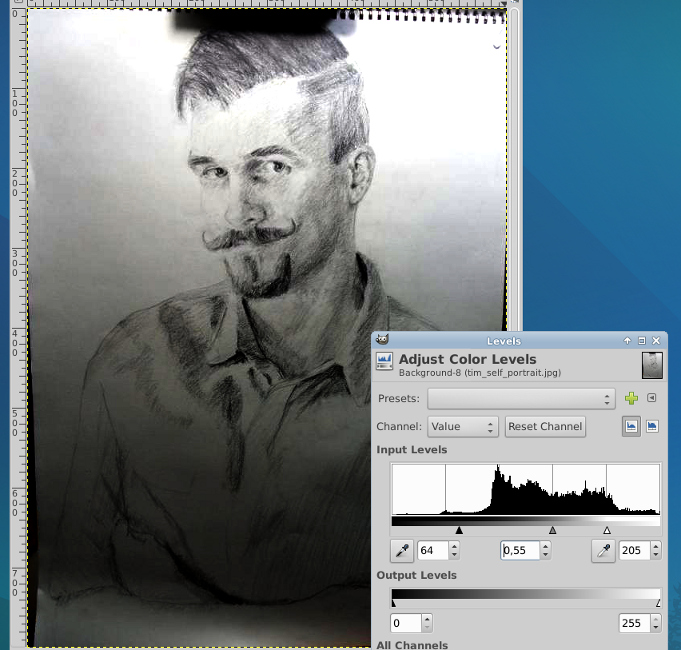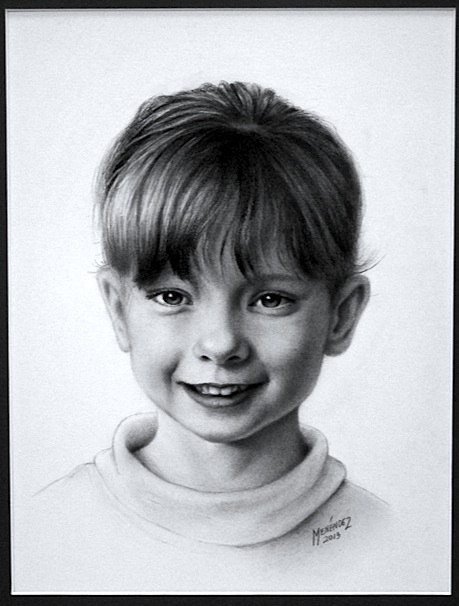How To Photograph Graphite Drawings
Photographing pencil drawings.
- This topic has 5 replies, 6 voices, and was last updated 5 years, 7 months ago by
 joshuaw.
joshuaw.
Viewing 6 posts - 1 through 6 (of 6 total)
-
Author
Posts
-
April 11, 2016 at 4:33 pm #993994
My sons and I do a number of pieces in pencil, for our own entertainment, and I find photographing them is incredibly difficult to bring out the subtlety which graphite can obtain.
When I am photographing these drawings, in order to gain the gradations of gray the paper is under exposed and everything looks gray. If I photograph and bring the paper to its proper value (near white), then the camera washes out the values of the shading and often obliterates any of the values in light areas of the drawings.
For example, my son recently completed an assignment for a self portrait in pencil his class, and when we photographed it, the resulting picture shows gray rather than white. I have tried numerous settings, bright lights, tripods, long exposures and adjusting things in GIMP, but to no avail.
If someone has some hints on how to photograph these to get something closer to accurate, I am all ears.
I have tried scanning this type of picture, but it looks the same. My wife's Nikon D-90 gives the same results as the point and shoot I use, so I don't think it is the lens or camera per-se.
I am not looking to make reprints or anything, just being able to make a better recorded image.
An example of how it turns out…

He really does have that mustache, and he did a pretty good job. He's only been studying for about two years, and I am pretty proud of the job he did, but this picture misses a great deal of delicacy which is contained within the paper.
Any hints on how to make a better photo of this type of drawing? I photograph my paintings better than I can obtain of graphite drawings.
April 11, 2016 at 6:20 pm #1250007
 Anonymous
Anonymous Use "post-processing"

But it is very important to obtain an equal lighting, your photo is much brighter at the top. That is almost impossible to correct with graphic manipulation.
Enhancing both bright and dark and adjusting the gradation is a standard tool in image manipulation. I use GIMP (free).Just a few minutes work to show the principle: (writing this text took longer)

Enhancing dark by shifting the "black point", enhancing bright by shifting the "white point" and manipulating the gradation with the "gamma".
But as you see the unequal lighting becomes even more apparent.

April 11, 2016 at 8:03 pm #1250006
I am also curious as to just how dark the graphite actually is … and how much of the paper is left plain white. Graphite can be incredibly difficult to photograph – mine usually have hot and cold spots which is annoying. I have found, however, that leaving plain white paper can be problematic if using lights. As a result I always am sure my subject has a full coating/layer of graphite on everything. In fact, the only white paper I leave behind in a portrait is water reflections (highlights in the eyes for instance). All other areas, regardless of how light, are some value of gray. The only possible exception to this is something in direct sunlight but this is very rare and usually doesn't lend itself well to a drawing.
All the professional setups I've seen for artificial light use a bright (generally tungsten) light on each side at about a 45* angle so the drawing is washed in bright light. I try this and get poor results – but I'm no photographer. Armin Mersmann, a remarkable artist, uses diffused sunlight through a window for lighting and gets amazing results. His drawings are fairly dark, however, and rarely have any bare paper.
Some artists use charcoal to darken their work as well, Here is one of mine that was only graphite and slightly retouched to bring out the darks … but it gives a good idea of the values used. In the end the values on his cheeks were not dark enough leaving them looking somewhat washed out.

Here's one with a lot of white paper showing … notice the hot and cold spots … sigh.

April 12, 2016 at 5:10 pm #1250008
Have you tried setting a custom white balance to match the colour of your paper? Here`s what i mean in the link.
https://www.youtube.com/watch?v=ygYRCkVfPu0April 13, 2016 at 5:51 am #1250009
Most of my photos, if not all, are taken using my iPhone, which has a good resolution and is easy to take photos from. I take several photos using different scenarios or lightning but I do not use focal light to avoid disparity on the final result. I then I chose the best, like in this photo of the little girl.
Occasionally, I use my Nikon D500 and adjust the white balance. However, I prefer my iPhone for most of my pictures.


April 13, 2016 at 8:19 am #1250010
HDR pics give a good result in some cases, my mobile camera will make a good balance between whites and dark when HDR is used. I've not correctly photographed my graphite drawings, basically because they are under a glass.
To really get the result you need to make calculations of focal point, set camera manually with the appropriate lens for the focal distance, measure the light and type of light (sun light is best IMO) in a controlled environment, and do several shots with different ISO level, aperture and shutter time. Then select the best one that resembles the drawing/painting reality.
Best camera settings are low ISO (less noise from amplification), high aperture (more light to the sensor), and long shutter time (time of opening the diaphragm). Of course taken with a tripod, with remote and with mirror pre-enabled to avoid any movement (blurriness) ). Take the Pictures in RAW file format in the highest resolution possible.
I'm no pro, but those are the basics

Federico Garcia
My Blog
C&C always welcome
"...when someone gives a critique of your work, fear not. It usually means they like or care more of your work than when they just pat your back." - Tiago
-
Author
Posts
Viewing 6 posts - 1 through 6 (of 6 total)
- You must be logged in to reply to this topic.
How To Photograph Graphite Drawings
Source: https://www.wetcanvas.com/forums/topic/photographing-pencil-drawings/
Posted by: cochranhaustrand.blogspot.com

0 Response to "How To Photograph Graphite Drawings"
Post a Comment